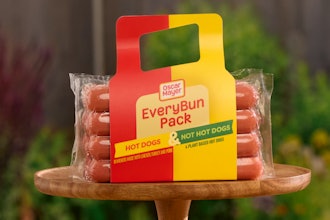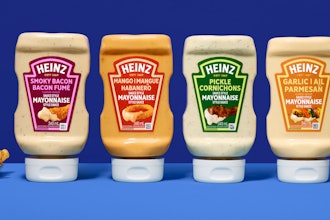
 Angela Fernandez, Vice President of Retail Grocery and Foodservice, GS1 US
Angela Fernandez, Vice President of Retail Grocery and Foodservice, GS1 USThe relationships and interactions between brand owners, retailers and consumers are changing in our increasingly digital, always-connected landscape. Comparison shopping has taken on new meaning with the advent of online retailers and e-marketplaces, and with social media’s growing role in influencing consumer opinions. On top of that, increasing consumer interest in a brand’s character, from environmental sustainability to nutritional and sourcing information, is driving new product information requirements — especially when it comes to food. These and other evolutional shifts will usher in a lot of changes in 2017 and beyond.
It’s All About Transparency
Transparency will continue to take center stage as a top priority in the coming year. More than ever before, consumers want to know where their food comes from, how it is made and other important information that could influence their purchase decisions. Several regulatory requirements are driving major changes that reflect consumer demands as well, including mandated labeling of genetically modified (GMO) foods, the Food Safety Modernization Act (FSMA) and changes to the Nutrition Facts Panel. Consumer demand and regulatory requirements together have created an imperative, whose time has come, for greater product transparency.
Brand owners and retailers have the opportunity to meet and exceed consumer expectations by leveraging interoperable data standards to ensure consistency and availability of comprehensive product information throughout the supply chain. Supply chain visibility based on GS1 Standards addresses the consumer call for detailed product information, while also providing industry partners the information they need to increase efficiency, improve stocking patterns to optimize “on-shelf” availability and pinpoint potentially harmful products.
Data Quality: Everyone Wins
Just as important is the prioritization of improving data quality. Often, the product information that consumers find through Internet searches is inaccurate or outdated, which can damage their trust in a brand. Not only that, the consequences of bad data are felt throughout the supply chain as well. For example, GS1 US, the information standards organization and administrator of the U.P.C. barcode, found through recent company audits that inaccurate data linked to foundational product attributes, such as weights and dimensions, continues to cause difficulties. Calculating the efficient transport of product becomes problematic — and in today’s highly automated warehouses, entire loading operations can be shut down if the data does not match the product’s actual weight or size. It doesn’t stop there — when inaccurate dimensional data is supplied to retailers, shelf space allocations are improperly allocated.
The global standardization of product information enables companies to ensure complete and accurate data exchange in accordance with industry best practices, preventing such breakdowns in supply-chain efficiency. GS1 Standards power automatic data capture for efficient information sharing among trading partners. A barcode that contains a Global Trade Item Number (GTIN) can allow companies to track and trace a product and to exchange standardized product information for improved supply chain visibility and transparency.
Tremendous benefits are shared between all stakeholders in the supply chain:
- Item and case data accuracy provides cost savings in improved trailer optimization, warehouse storage efficiencies and elimination of inaccurate weights and measures.
- Risk is mitigated and costs are avoided because digital orders match physical products and consumers are able to see accurate product nutrition information, including ingredients and allergens, before purchase.
- Enhanced collaboration between trading partners improves relationships, expedites new item setups, allows greater plan-o-gram accuracy and improves U.P.C. transitions.
- Retailer execution is improved through accurate order deliveries, reduced out-of-stocks, improved speed-to-shelf execution, more effective promotion execution and an integrated digital experience.
- Last but never least, shopper benefits include a comprehensive and seamless shopping experience with improved on-shelf availability.
The ultimate value of data quality excellence, in compliance with industry standards, is an increase in consumers’ brand confidence and retailer loyalty.

Renewed Commitment to Food Safety
The major food recalls of 2016 sparked a renewed focus on food safety vigilance for all stakeholders. In 2017, all members of the food supply chain will continue to be under pressure to optimize traceability programs so that, in the event of a major recall, they can respond quickly. Effective traceability programs allow companies to know where a product is — and where it has been — at all times. When a foodborne illness outbreak occurs, this makes it possible to pinpoint affected products and remove them from the supply chain, protecting public health and brand reputations. Global standards enable the supply chain visibility needed to make this level of traceability work.
Implementing full supply chain visibility is a massive undertaking requiring widespread cooperation. Two GS1 US initiatives — the GS1 US Retail Grocery Initiative and the Foodservice GS1 US Standards Initiative — seek to facilitate discussions between industry stakeholders as they face the challenges associated with developing and implementing traceability programs.
The Rise of E-Commerce
E-commerce in the food industry is on the rise as consumers increasingly seek a faster, more streamlined shopping experience. A 2015 Nielsen survey found that a quarter of respondents ordered their groceries online for home delivery. Fifty-five percent reported that they were willing to do so in the future. To be successful, retailers will need to blend digital and physical marketplaces.
Grocery e-commerce, which provides a platform for consumers to research, purchase and use products without ever stepping foot inside a grocery store, is projected to gain even more momentum in the coming year, according to BI Intelligence research. Food manufacturers and retailers can best take advantage of this growing market by ensuring that their product information is accurate, complete and up-to-date, and by working with online food retailers and app developers to make that information available to consumers.
Digital Coupons
According to PwC’s Total Retail Survey 2016, 34 percent of shoppers are now using mobile coupons and promotional coupon codes. Mobile coupons have been shown to increase customer spending and loyalty. According to a recent Digital Coupon Marketing report, 59 percent of consumers said that out of all the promotions a retailer may use, digital coupons make the biggest difference in their purchasing decisions.
An effective digital couponing program requires a standardized way to offer, track and reconcile both paper and paperless coupons. The retail sector will need to address growing mobile coupon use and to differentiate paper from paperless coupon redemption standards for transaction auditability. The solution must not only enable efficient operations with back-end systems but also work well with public-facing applications and websites that support today’s digitally-savvy consumer no matter where or how they shop.
To help the transition to mobile couponing along, the Joint Industry Coupon Committee (JICC) and GS1 US created a new standard (8112 AI) that allows both physical and digital coupons to be used at point-of-sale. This system results in more effective promotions and better accountability for paperless transactions. These standards will benefit industry partners at all levels by providing traceability to the till, the ability to settle digital and paper coupons at the point of sale and increased efficiencies throughout the couponing/redemption process.
Not Your Mother’s Grocery Store
While retailing and shopping evolve to leverage technology’s pervasive impact on markets and lifestyles, industry leaders are working to meet consumers where they are. That often means “on their smartphones.” System-wide benefits will be realized as consumer wish lists and demands are met with collaborative, interoperable industry solutions that work across channels.
Consumers will find it easier, faster and more satisfying to find the information they want before they buy, in formats that make sense from brand to brand and store to store.
Additionally, everyone benefits from improved food safety. Brands and retailers will benefit from the increased consumer engagement and loyalty that follows. The food industry landscape will continue its trajectory of dramatic changes in 2017, all in the name of progress.
About the author
Angela Fernandez is the vice president of retail grocery and foodservice for GS1 US based in Lawrenceville, New Jersey, leading the GS1 US Retail Grocery Initiative and the Foodservice GS1 US Standards Initiative. She collaborates with industry leaders and key trade associations to understand industry supply chain challenges and address how the use of GS1 Standards can help solve those challenges.























